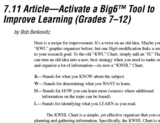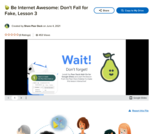
This brief online article introduces readers to 5 effective skills for safe, culturally sensitive, and ethical online communication.
- Subject:
- Professional Learning
- Material Type:
- Reading
- Provider:
- Browser Media
- Date Added:
- 10/02/2023

This brief online article introduces readers to 5 effective skills for safe, culturally sensitive, and ethical online communication.

Educator and author Kristen Mattson, Ed.D., has a bone to pick with a lot of the digital citizenship curricula used in schools today. Too much of it, she says, focuses on what not to do, and it rarely addresses the opportunities and responsibilities of the digital world. In addition, much of it is isolated from any real context and doesn’t give students many opportunities to practice their skills as citizens of digital communities. This article explores strategies to help digital citizens engage with empathy.

This article describes how teachers can effectively teach digital citizenship and provides resources to help teachers learn more about weaving digital citizenship throughout instruction.

The Triple E Framework, developed in 2011 by Professor Liz Kolb at the University of Michigan, School of Education, was created to address the desire for K-12 educators to bridge research on education technologies and teaching practice in the classroom.

This lesson plan (2 of 4) shows students what to do when they want new music, movies, images, even software. Students learn how to do this in ways that are legal and ethical and how to recognize the good players who provide content legally vs. those who encourage illegal filesharing.. The plan includes a pdf, Slides, and a video.

As consumers we go online to find music, movies, games, images, software, and more. When we find the media we love, we often want to share it. In this lesson, students learn: How to get music, movies, and other media from lawful providers who respect the rights of artists and how to share media in ways that are legal and ethical.

The Big6 is a six-stage model to help anyone solve problems or make decisions by using information. Students can use this model to guide them through the research process. This resource is an article describing how to use a KWHL chart to help student through the research process.

The Big6 is a six-stage model to help anyone solve problems or make decisions by using information. Students can use this model to guide them through the research process. This resource describes a Big6 lesson focused on research that follows the Big6 model.

Google’s digital safety curriculum is focused on teaching students to be smart, alert, strong, kind, and brave online.

Unit 1 of Google’s digital safety curriculum is focused on teaching students to protect yourself, your information, and your privacy online.

Unit 2 of Google’s digital safety curriculum is focused on teaching students to steer clear of scammers, fakers, info that doesn't help and other Internet stuff that tries to trick your brain - and learning how to find the good stuff.

Unit 3 of Google’s digital safety curriculum is focused on teaching students to get real about privacy and security.

Unit 4 of Google’s digital safety curriculum is focused on teaching students to learn and practice the power of online kindness

Unit 5 of Google’s digital safety curriculum is focused on teaching students to define and encourage Internet Brave behavior.

This resource is a Google Slides/Pear Deck lesson you can use in your classroom. Many details that raise "red flags" for adults can go overlooked by kids. Help them learn what they are, what to look for, and how to "trust their gut" when they encounter suspicious or possibly harmful emails, websites, and apps.

This resource is a Google Slides/Pear Deck lesson you can use in your classroom. Many details that raise "red flags" for adults can go overlooked by kids. Help them learn what they are, what to look for, and how to "trust their gut" when they encounter suspicious or possibly harmful emails, websites, and apps.

This resource is a Google Slides/Pear Deck lesson you can use in your classroom. Many details that raise "red flags" for adults can go overlooked by kids. Help them learn what they are, what to look for, and how to "trust their gut" when they encounter suspicious or possibly harmful emails, websites, and apps.

This resource is a Google Slides/Pear Deck lesson you can use in your classroom. Many details that raise "red flags" for adults can go overlooked by kids. Help them learn what they are, what to look for, and how to "trust their gut" when they encounter suspicious or possibly harmful emails, websites, and apps.

This resource is a Google Slides/Pear Deck lesson you can use in your classroom. Many details that raise "red flags" for adults can go overlooked by kids. Help them learn what they are, what to look for, and how to "trust their gut" when they encounter suspicious or possibly harmful emails, websites, and apps.

This resource is a Google Slides/Pear Deck lesson you can use in your classroom. Many details that raise "red flags" for adults can go overlooked by kids. Help them learn what they are, what to look for, and how to "trust their gut" when they encounter suspicious or possibly harmful emails, websites, and apps.